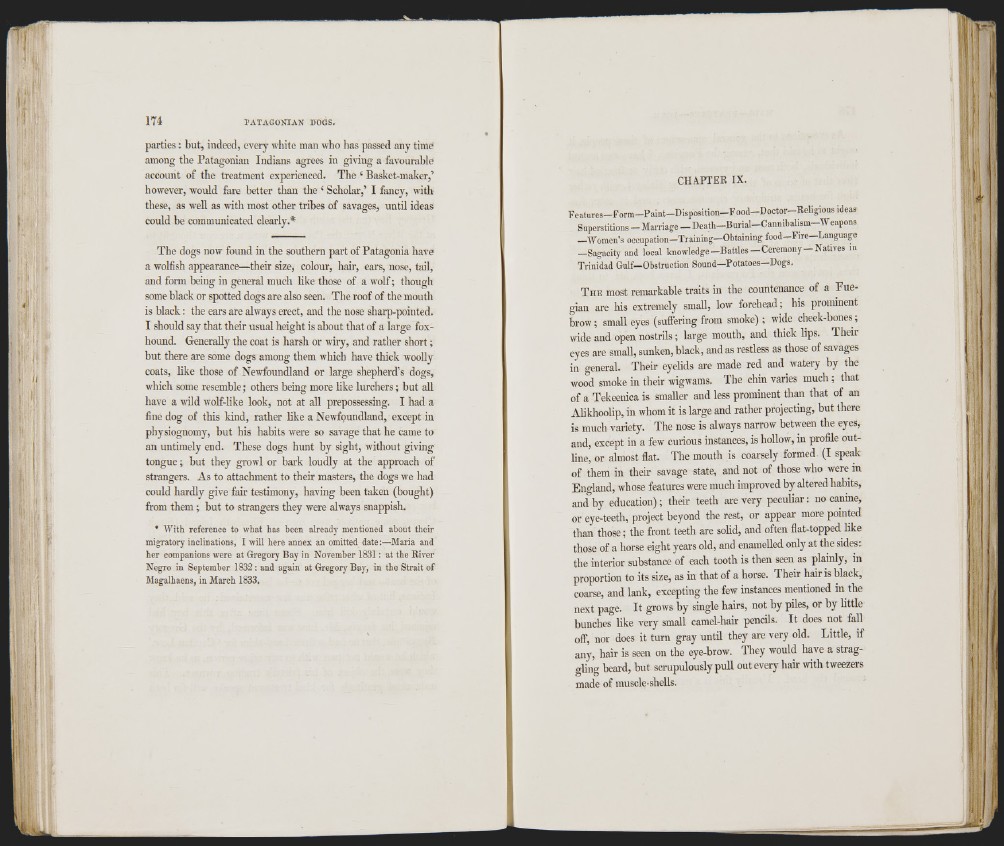
! r
<i j
' III
I li :
|i -
parties : b u t, indeed, every wliite man who has passed any time
among the Patagonian Indians agrees in giving a favourable
account o f th e treatment experienced. The ‘ Basket-maker,’
however, would fare better th an the ‘ Scholar,’ I fancy, with
these, as well as with most other tribes o f savages, un til ideas
could be communicated clearly.*
T h e dogs now found in the southern p a rt o f Patagonia have
a wolfish appearance—their size, colour, hair, ears, nose, tail,
and form being in general much like those of a wo lf; though
some black or spotted dogs are also seen. T h e roof of the mouth
is b la c k : the ears are always erect, and the nose sharp-pointed.
I should say th a t th eir usual height is about th a t of a large foxhound.
GeneraUy the coat is harsh or why, and ra th e r sh o r t;
b u t there are some dogs among them which have thick woolly
coats, h k e those of Newfoundland or large shepherd’s dogs,
which some resemble; others being more like lu rch e rs; b u t all
have a wild wolf-like look, not at all prepossessing. I had a
fine dog of this kin d , ra th e r hke a Newfoundland, except in
physiognomy, b u t his habits were so savage th a t he came to
an untimely end. These dogs h u n t b y sight, without giving
to n g u e ; b u t they growl or b a rk loudly a t the approach of
strangers. As to attachment to th eir masters, the dogs we had
could hardly give fair testimony, having been taken (bought)
from them ; b u t to strangers they were always snappish.
• With reference to what has been already mentioned about their
migratory inclinations, I will here annex an omitted date:—Maria and
her companions were at Gregory Bay in November 1831; at the River
Negro in September 1832: and again at Gregory Bay, in the Strait of
Magalhaens, in March 1833.
CHAPTER IX.
F e a t u r e s - F o rm - P a l n t -D i s p o s i t i o n - F o o d -D o c t o r -R e l i g i o u s ideas
S u p e rstitio n s - M a rriag e - D e a th -B u r i a l -C a n n ib a l i sm -W e a p o n s
—W om en ’s occupation—T r a in in g—O b ta in in g food—F ir e—L an g u ag e
- S a g a c i y an d local k n o w l e d g e -B a t t l e s — C erem ony — N a tiv e s in
T r in id a d Gulf—Obstruction Sound—P o ta to e s—Dogs,
T h e most remarkable traits in the countenance of a F u e gian
are his extremely small, low forehead; his prominent
brow; s m a l l e y e s (suffering from smoke); wide cheek-bones;
wide and open nostrils ; large mouth, and thick lips. T h e ir
eyes are small, sunken, black, and as restless as those of savages
in general. T h e ir eyelids are made red and watery b y the
wowl smoke in their wigwams. T h e chin varies much ; th a t
of a Tekeenica is smaller and less prominent than th a t of an
Alikhoolip, in whom it is large and ra th e r projecting, b u t there
is much variety. The nose is always narrow between the eyes,
and, except in a few curious instances, is hollow, in profile ou tline,
or almost flat. The mouth is coarsely formed ( I speak
o f them in their savage state, and not of those who were in
Eno-land, whose features were much improved by altered habits,
a n d \ y education); their teeth are very p e cu lia r: no canine,
or eye-teeth, project beyond the rest, or appear more pointed
th an th o se ; the front teeth are sohd, and often flat-topped like
those of a horse eight years old, and enamelled only a t the sides:
the interior substance of each tooth is then seen as plainly, in
proportion to its size, as in th a t of a horse. T h e ir hair is black,
coai-se, and lank, excepting the few instances mentioned in the
next page. I t grows b y single hairs, no t b y piles, or b y little
bunches like very small camel-hair pencils. I t does n o t fall
off, nor does it tu rn gray u n til they are very old. L ittle , if
any, hair is seen on the eye-brow. They would have a straggling
beai-d, b u t scrupulously p u ll out every hair with tweezers
made of muscle-shells.
Ai !